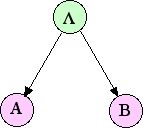Template:Numbered block/doc
| This is a documentation subpage for Template:Numbered block. It may contain usage information, categories and other content that is not part of the original template page. |
This template creates a numbered block which is usually used to number mathematical formulae. This template can be used together with {{EquationRef}} and {{EquationNote}} to produce nicely formatted numbered equations if a back reference to an equation is wanted.
Parameters
Command: {{NumBlk|<1>|<2>|<3>|RawN=<>|LnSty=<>|Border=<>}}
Parameters {{{1}}}, {{{2}}}, and {{{3}}} of this template are required. In addition, there are three optional parameters {{{RawN}}}, {{{LnSty}}} and {{{Border}}}.
- {{{1}}}: Specify indentation. The more colons (:) you put, the further indented the block will be, up to a limit of 20. This parameter can be empty if no indentation is needed.
- {{{2}}}: The body or content of the block.
- {{{3}}}: Specify the block number.
- {{{RawN}}}: If a non-empty non-whitespace value, no extra formatting will be applied to the block number.
- {{{LnSty}}}: Specify the line style.
- {{{Border}}}: If set, put a box around the equation. (Experimental.)
Examples
Equations may render HTML | ||||||||||||||||||||||
|---|---|---|---|---|---|---|---|---|---|---|---|---|---|---|---|---|---|---|---|---|---|---|
|
|
| |||||||||||||||||||||
|
|
| |||||||||||||||||||||
|
|
| |||||||||||||||||||||
Indentation | ||||||||||||||||||||||
|
|
| |||||||||||||||||||||
|
|
| |||||||||||||||||||||
|
|
| |||||||||||||||||||||
|
|
| |||||||||||||||||||||
Formatting of equation number | ||||||||||||||||||||||
|
|
| |||||||||||||||||||||
|
|
| |||||||||||||||||||||
|
|
| |||||||||||||||||||||
|
|
| |||||||||||||||||||||
|
|
| |||||||||||||||||||||
|
|
| |||||||||||||||||||||
|
|
| |||||||||||||||||||||
Line style | ||||||||||||||||||||||
|
|
| |||||||||||||||||||||
|
|
| |||||||||||||||||||||
|
|
| |||||||||||||||||||||
|
|
| |||||||||||||||||||||
|
|
| |||||||||||||||||||||
|
|
| |||||||||||||||||||||
|
|
| |||||||||||||||||||||
Line height and indentation (1) | ||||||||||||||||||||||
The following equations
:<math>3x+2y-z=1</math>
:<math>2x-2y+4z=-2</math>
:<math>-2x+y-2z=0</math>
form a system of three equations.
|
The following equations form a system of three equations. | |||||||||||||||||||||
The following equations
{{NumBlk|:|<math>3x+2y-z=1</math>|1}}
{{NumBlk|:|<math>2x-2y+4z=-2</math>|2}}
{{NumBlk|:|<math>-2x+y-2z=0</math>|3}}
form a system of three equations.
|
The following equations
form a system of three equations. | |||||||||||||||||||||
The following equations
<div style="line-height: 0.7105;">
{{NumBlk|:|<math>3x+2y-z=1</math>|1}}
{{NumBlk|:|<math>2x-2y+4z=-2</math>|2}}
{{NumBlk|:|<math>-2x+y-2z=0</math>|3}}
</div>
form a system of three equations.
|
The following equations
form a system of three equations. | |||||||||||||||||||||
The following equations
<div style="line-height: 0.7105;">
{{NumBlk||<math>3x+2y-z=1</math>|1}}
{{NumBlk||<math>2x-2y+4z=-2</math>|2}}
{{NumBlk||<math>-2x+y-2z=0</math>|3}}
</div>
form a system of three equations.
|
The following equations
form a system of three equations. | |||||||||||||||||||||
The following equations
<div style="line-height: 0.7105; margin-left: 1.6em;">
{{NumBlk||<math>3x+2y-z=1</math>|1}}
{{NumBlk||<math>2x-2y+4z=-2</math>|2}}
{{NumBlk||<math>-2x+y-2z=0</math>|3}}
</div>
form a system of three equations.
|
The following equations
form a system of three equations. | |||||||||||||||||||||
Line height and indentation (2) | ||||||||||||||||||||||
The following equations
:<math>3x+2y-z=1</math>
::<math>2x-2y+4z=-2</math>
:::<math>-2x+y-2z=0</math>
form a system of three equations.
|
The following equations form a system of three equations. | |||||||||||||||||||||
The following equations
<div style="line-height: 0.7105; margin-left: 1.6em;">
{{NumBlk||<math>3x+2y-z=1</math>|1}}
<div style="margin-left: 1.6em;">
{{NumBlk||<math>2x-2y+4z=-2</math>|2}}
<div style="margin-left: 1.6em;">
{{NumBlk||<math>-2x+y-2z=0</math>|3}}
</div>
</div>
</div>
form a system of three equations.
|
The following equations
form a system of three equations. | |||||||||||||||||||||
The following equations
<div style="line-height: 0.7105;">
<div style="margin-left: calc(1.6em * 1);">
{{NumBlk||<math>3x+2y-z=1</math>|1}}
</div>
<div style="margin-left: calc(1.6em * 2);">
{{NumBlk||<math>2x-2y+4z=-2</math>|2}}
</div>
<div style="margin-left: calc(1.6em * 3);">
{{NumBlk||<math>-2x+y-2z=0</math>|3}}
</div>
</div>
form a system of three equations.
|
The following equations
form a system of three equations. | |||||||||||||||||||||
Unordered list | ||||||||||||||||||||||
* <math>3x+2y-z=1</math>
* <math>2x-2y+4z=-2</math>
* <math>-2x+y-2z=0</math>
|
| |||||||||||||||||||||
* {{NumBlk||<math>3x+2y-z=1</math>|Eq. 1}}
* {{NumBlk||<math>2x-2y+4z=-2</math>|Eq. 2}}
* {{NumBlk||<math>-2x+y-2z=0</math>|Eq. 3}}
|
| |||||||||||||||||||||
<ul style="line-height: 0.7105;">
<li><div style="display: inline-block; width: 100%; vertical-align: middle;">{{NumBlk||<math>3x+2y-z=1</math>|Eq. 1}}</div></li>
<li><div style="display: inline-block; width: 100%; vertical-align: middle;">{{NumBlk||<math>2x-2y+4z=-2</math>|Eq. 2}}</div></li>
<li><div style="display: inline-block; width: 100%; vertical-align: middle;">{{NumBlk||<math>-2x+y-2z=0</math>|Eq. 3}}</div></li>
</ul>
|
| |||||||||||||||||||||
<ul style="line-height: 0.7105;">
<li><div style="display: inline-table; width: 100%; vertical-align: middle;">{{NumBlk||<math>3x+2y-z=1</math>|Eq. 1}}</div></li>
<li><div style="display: inline-table; width: 100%; vertical-align: middle;">{{NumBlk||<math>2x-2y+4z=-2</math>|Eq. 2}}</div></li>
<li><div style="display: inline-table; width: 100%; vertical-align: middle;">{{NumBlk||<math>-2x+y-2z=0</math>|Eq. 3}}</div></li>
</ul>
|
| |||||||||||||||||||||
Ordered list | ||||||||||||||||||||||
# <math>3x+2y-z=1</math>
# <math>2x-2y+4z=-2</math>
# <math>-2x+y-2z=0</math>
|
| |||||||||||||||||||||
# {{NumBlk||<math>3x+2y-z=1</math>|Eq. 1}}
# {{NumBlk||<math>2x-2y+4z=-2</math>|Eq. 2}}
# {{NumBlk||<math>-2x+y-2z=0</math>|Eq. 3}}
|
| |||||||||||||||||||||
<ol style="line-height: 0.7105;">
<li><div style="display: inline-block; width: 100%; vertical-align: middle;">{{NumBlk||<math>3x+2y-z=1</math>|Eq. 1}}</div></li>
<li><div style="display: inline-block; width: 100%; vertical-align: middle;">{{NumBlk||<math>2x-2y+4z=-2</math>|Eq. 2}}</div></li>
<li><div style="display: inline-block; width: 100%; vertical-align: middle;">{{NumBlk||<math>-2x+y-2z=0</math>|Eq. 3}}</div></li>
</ol>
|
| |||||||||||||||||||||
<ol style="line-height: 0.7105;">
<li><div style="display: inline-table; width: 100%; vertical-align: middle;">{{NumBlk||<math>3x+2y-z=1</math>|Eq. 1}}</div></li>
<li><div style="display: inline-table; width: 100%; vertical-align: middle;">{{NumBlk||<math>2x-2y+4z=-2</math>|Eq. 2}}</div></li>
<li><div style="display: inline-table; width: 100%; vertical-align: middle;">{{NumBlk||<math>-2x+y-2z=0</math>|Eq. 3}}</div></li>
</ol>
|
| |||||||||||||||||||||
Border | ||||||||||||||||||||||
|
|
| |||||||||||||||||||||
Positioning relative to surrounding images
Numbered blocks should be able to be placed around images that take up space on the left or right side of the screen. To ensure numbered block has access to the entire line, consider using a {{clear}}-like template.
To illustrate, consider the example:
If it is desirable for the numbered block to span the entire line, a {{clear}} should be placed before it.
| Markup | [[Image:Bnet_fan2.png|frame|right|Fig.1: Bayesian Network representation of Eq.(6)]]
[[Image:Bnet_fan2.png|frame|left|Fig.1: Bayesian Network representation of Eq.(6)]]
<br><br>A Bayesian network (or a belief network) is a probabilistic graphical model that represents a set of
variables and their probabilistic independencies. For example, a Bayesian network could represent the
probabilistic relationships between diseases and symptoms. Given symptoms, the network can be used to compute
the probabilities of the presence of various diseases.
{{clear}}
{{NumBlk|1=:|2=<math>
P(a, b, \lambda) = P(a| \lambda) P(b | \lambda) P(\lambda)\,
</math>,|3='''Eq.(6)'''|RawN=.}}
| |||||||
|---|---|---|---|---|---|---|---|---|
| Renders as |  
|
Table caveat
Because {{NumBlk}} is implemented as a table, putting {{NumBlk}} within a table yields a nested table. Due to a bug in MediaWiki's handling of nested tables, {{NumBlk}} must be used carefully in this case. In particular, when indentation for the outer table is desired, use explicit <dl> tags for indentation instead of a leading colon (:).
<dd>...</dd></dl>
For example,
| Markup |
| |||||||||||
|---|---|---|---|---|---|---|---|---|---|---|---|---|
| Renders as |
|
which shows how the outer <dl> tags give the same indentation as a single colon (:) preceding the table should.
<dd>...</dd></dl>
For another example,
| Markup |
| ||||||||||||||||||||||||||||||||||||
| Renders as |
|
which uses two sets of explicit tags to give the same indentation as two colons (::).